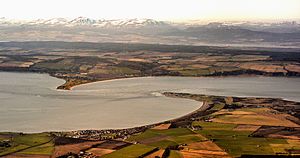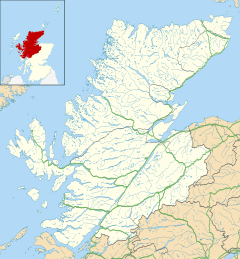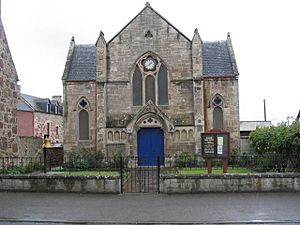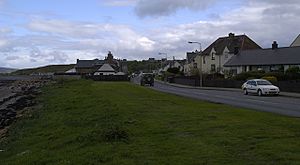Ardersier facts for kids
Quick facts for kids Ardersier
|
|
|---|---|
 |
|
| Population | Expression error: "Lua error in Module:Tabular_data at line 91: attempt to index field 'data' (a nil value)." must be numeric (2020) |
| OS grid reference | NH782550 |
| Council area | |
| Country | Scotland |
| Sovereign state | United Kingdom |
| Post town | Inverness |
| Postcode district | IV2 |
| Police | Northern |
| Fire | Highlands and Islands |
| Ambulance | Scottish |
| EU Parliament | Scotland |
| UK Parliament |
|
| Scottish Parliament | |
Ardersier (pronounced Ar-der-seer) is a charming small village in the Scottish Highlands. It sits right on the beautiful Moray Firth coastline. You can find it between the larger towns of Inverness and Nairn, very close to the historic Fort George.
The name Ardersier might come from the Gaelic words "Àird nan Saor." This means "Headland of the joiners" or "carpenters." One old story says that carpenters building churches across the Moray Firth stayed here. However, the name is much older than those churches. It more likely describes the area's natural shape: a high piece of land sticking out into the sea.
Before Fort George was built, a small fishing community lived nearby. Their lives revolved around fishing in the sea. When the fort was constructed, this community had to move. This move eventually led to the creation of the Ardersier village we know today.
Contents
A Journey Through Ardersier's Past
Ancient Connections: Knights Templar Lands
Long ago, some of the land around Ardersier was owned by the Knights Templar. This was a famous group of knights from the Middle Ages. These special lands were known by names like Temple Land and Temple Bank. They stretched between Connage and the sea, and Flemington and the sea.
Later, in 1626, a powerful family called Cawdor took ownership of these lands. There's also a mention of a "locus trialis" in Ardersier from ancient times. This might have been a special place where people settled disagreements or disputes.
Building Fort George: A New Home for Ardersier
After a big historical event called the Jacobite rising of 1745, people in Scotland were worried. They feared more conflicts, especially from the sea. To protect the area, a huge military base, Fort George, was planned. This fort was much larger than an earlier one in Inverness.
The fort was built in a very important spot, right where the Moray Firth narrows. This location was perfect for guarding the coastline. It also meant supplies could easily arrive by sea, even if the land routes were blocked.
Building the fort meant that the small fishing community living there had to move. They resettled about a mile away, along the shores of the Moray Firth. This relocation created two new settlements. One was called Stewart-town, and the other was Campbell-town. These two places eventually grew together and became known as Ardersier. The name Ardersier became official for postal services in the late 1970s. This helped avoid confusion with another town called Campbeltown in Argyll.
Ardersier Today: A Lively Community
Today, Ardersier is a popular place for visitors. People love the beautiful views of the Moray Firth and the peaceful shoreline. Its closeness to Fort George is also a big draw. Fort George is still an active base for the British Army.
The village has a few handy shops, including a Morrisons and a Spar. You can also find a pharmacy and a hairdressers. For those looking to stay, there are several bed and breakfasts, plus a pub with rooms.
The community in Ardersier is very active. In December 2009, local residents created their own company. Their goal was to take over community buildings and create a "Community Hub." This hub provides a central place for local activities and services.
A big project started in 2013 to renovate the Ardersier War Memorial Hall. This important building was reopened to the public in 2014. It now serves as a gathering place for many village events.

Notable People from Ardersier
Ardersier has been home to several interesting people:
- Lorne Balfe: A talented film composer who creates music for movies.
- Pryse Lockhart Gordon: Known for writing memoirs, which are personal stories about his life.
- Donald Laing: A farmer who also became involved in politics.
- Herbert Macpherson: Born in the village, he was a brave soldier who received the Victoria Cross. This is a very high award for courage.
- Peter Peacock: A politician from the Scottish Labour Party.




